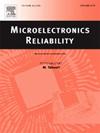微结构变化对焊点疲劳模拟的影响
IF 1.9
4区 工程技术
Q3 ENGINEERING, ELECTRICAL & ELECTRONIC
引用次数: 0
摘要
这项工作的目的是开发一种基于微观结构的模拟方法,以评估微电子行业使用的焊点的疲劳寿命。所开发的方法可通过三维 Voronoi 网格生成具有随机晶粒形态的焊点。每个晶粒的各向异性材料行为由 Garofalo 蠕变方程结合希尔对各向异性材料等效应力的定义来描述。晶粒边界作为界面元素实现,采用各向同性蠕变构成模型。通过生成 100 个包含 5 至 9 个晶粒的独特焊点(每个焊点的材料取向随机),对焊点蠕变响应的随机变异性进行了定性估计。在热循环过程中,这些焊点以微电子产品的实际应力水平独立加载。焊点中的体积平均蠕变应变能量密度被用来预测焊点的疲劳寿命。结果显示,单个焊点的预期寿命相差约 4 倍。接着,从上述 100 个焊点中随机抽取 9 个焊点,夹在硅芯片和印刷电路板之间,形成晶圆级芯片级封装 (WLCSP) 的仿真模型。对 34 个 WLCSP 的独特情况计算了接合处的蠕变应变能量密度。结果发现,焊点寿命的最高估计值和最低估计值之间相差约 2.5 倍。相应的 Weibull 分布的斜率等于 ~6,在报告的 WLCSP 焊点可靠性典型斜率范围内。本文章由计算机程序翻译,如有差异,请以英文原文为准。
Effect of microstructural variability on fatigue simulations of solder joints
The objective of this work is to develop a microstructure-based simulation approach to assess the fatigue life of solder joints that are used by the microelectronics industry. The developed approach can generate solder joints with random grain morphologies by means of 3D Voronoi tessellation. The anisotropic material behavior of each grain is described by the Garofalo creep equation combined with Hill's definition of the equivalent stress for anisotropic materials. Grain boundaries are implemented as interface elements, with an isotropic creep constitutive model. The stochastic variability in the creep response of solder joints was qualitatively estimated by generating 100 unique solder joints containing 5 to 9 grains, each having a random material orientation. These joints were independently loaded with a realistic stress level for microelectronic products during thermal cycling. The volume-averaged creep strain energy density in the solder joints was used to predict the fatigue life of the solder joints. The results showed a factor of ~4 difference in expected lifetime of the individual solder joints. Next, nine randomly picked solder joints from the above-mentioned pool of 100 were sandwiched between a silicon die and a printed circuit board to form a simulation model of a Wafer-Level Chip-Scale package (WLCSP). The creep strain energy density in the joints was computed for 34 unique cases of the WLCSP. A factor of ~2.5 between the highest and lowest estimate for the solder joint life was found. The slope of the corresponding Weibull distribution equals ~6, which falls within the slopes typical reported for solder joint reliability of WLCSPs.
求助全文
通过发布文献求助,成功后即可免费获取论文全文。
去求助
来源期刊

Microelectronics Reliability
工程技术-工程:电子与电气
CiteScore
3.30
自引率
12.50%
发文量
342
审稿时长
68 days
期刊介绍:
Microelectronics Reliability, is dedicated to disseminating the latest research results and related information on the reliability of microelectronic devices, circuits and systems, from materials, process and manufacturing, to design, testing and operation. The coverage of the journal includes the following topics: measurement, understanding and analysis; evaluation and prediction; modelling and simulation; methodologies and mitigation. Papers which combine reliability with other important areas of microelectronics engineering, such as design, fabrication, integration, testing, and field operation will also be welcome, and practical papers reporting case studies in the field and specific application domains are particularly encouraged.
Most accepted papers will be published as Research Papers, describing significant advances and completed work. Papers reviewing important developing topics of general interest may be accepted for publication as Review Papers. Urgent communications of a more preliminary nature and short reports on completed practical work of current interest may be considered for publication as Research Notes. All contributions are subject to peer review by leading experts in the field.
 求助内容:
求助内容: 应助结果提醒方式:
应助结果提醒方式:


